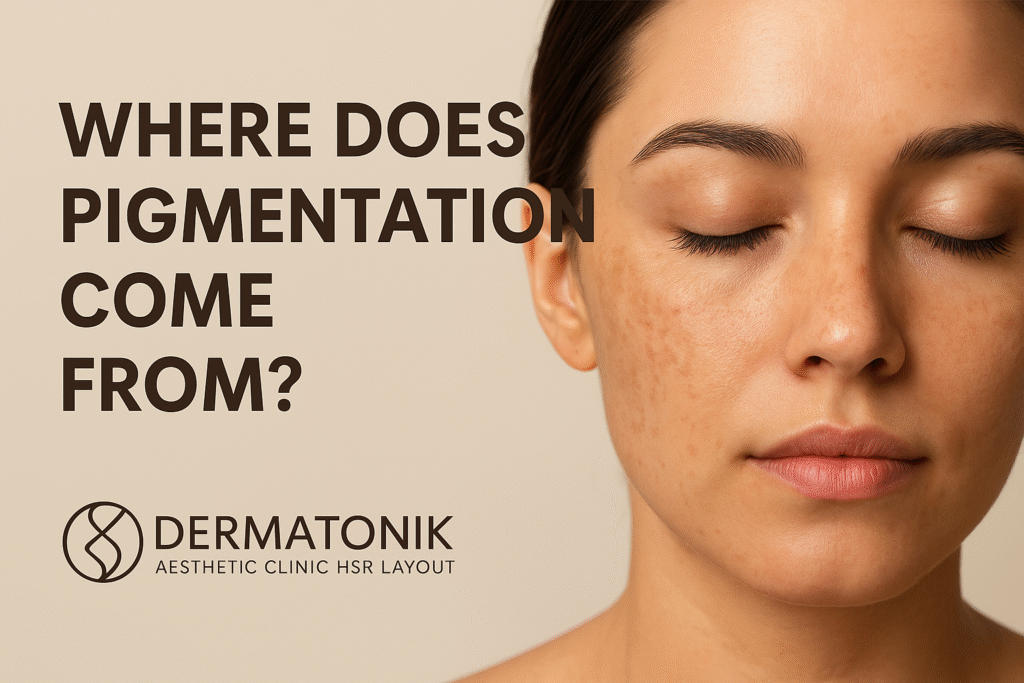Pigmentation is one of the most common skin concerns faced by people across all age groups. Whether it appears as stubborn dark patches on your cheeks, uneven skin tone, or age spots, pigmentation can often affect confidence and self-image. Many people struggling with these issues ask the same question: “Where does pigmentation come from?”
At Dermatonik Aesthetic Clinic HSR Layout, we specialize in diagnosing the root causes of pigmentation and providing targeted solutions that work. With years of expertise and advanced treatment technology, our clinic in Bangalore has helped countless patients restore their skin’s natural glow.
In this article, we’ll explore:
The basics of skin pigmentation and melanin
The primary causes of pigmentation
Different types and their origins
Triggers that worsen pigmentation
Preventive measures and early care
Professional treatment options available at Dermatonik HSR Layout
Let’s dive into understanding pigmentation at its roots.
1. Understanding Skin Pigmentation: The Basics
What is Pigmentation?
Pigmentation refers to the coloring of the skin, determined primarily by melanin—a natural pigment produced by specialized cells known as melanocytes. While melanin protects our skin from harmful UV radiation, imbalances in its production can lead to visible pigmentation problems.
The Role of Melanin Production
Melanin is the skin’s defense mechanism against sun damage. When UV rays penetrate the skin, melanocytes become active and release melanin as a shield. However, excessive or uneven production of melanin leads to patches of discoloration, commonly seen as dark spots or blotchy skin tone.
Melanocyte Activity and Function
Melanocytes reside in the basal layer of the skin’s epidermis. Each melanocyte connects to multiple keratinocytes, distributing melanin across the skin surface. Overactivity or irregular function of melanocytes is one of the primary skin pigmentation origins.
Key takeaway: Pigmentation is not just a superficial issue—it is deeply connected to melanin pigmentation sources, genetic factors, and environmental influences.
2. Primary Causes: Where Does Pigmentation Come From?
Pigmentation has multiple root causes. Let’s break down the most common ones:
Sun Exposure and UV Damage
UV rays are the biggest culprits. Prolonged sun exposure leads to tanning, sun spots, and uneven pigmentation. Where does sun pigmentation come from? It originates when UV radiation overstimulates melanocytes, triggering excess melanin production.
Hormonal Changes
Pregnancy, menopause, and hormonal treatments can alter melanin activity. What causes pigmentation during pregnancy? The surge of estrogen and progesterone stimulates melanocytes, resulting in melasma—often called the “mask of pregnancy.”
Age-Related Factors
Where does age pigmentation come from? Over the years, cumulative sun damage and natural aging cause melanin clumping. These appear as liver spots, age spots, or solar lentigines, typically on sun-exposed areas like the face and hands.
Genetic Predisposition
For some, pigmentation is hereditary. People with darker skin tones are more prone to hyperpigmentation due to naturally active melanocytes.
Keywords in context: If you’ve wondered what causes dark pigmentation on skin, it can be traced to these pigmentation triggers—UV rays, hormonal shifts, aging, and genetics.
3. Specific Types and Their Origins
Different pigmentation conditions have distinct origins:
Melasma
Where does melasma pigmentation come from? Melasma is triggered by a mix of hormonal changes, sun exposure, and genetic predisposition. It usually appears as symmetrical brown patches on the cheeks, forehead, and upper lip.
Post-Inflammatory Hyperpigmentation (PIH)
Where does post-inflammatory pigmentation come from? PIH develops after acne, injuries, or skin treatments. Inflammation signals melanocytes to release excess melanin, leaving behind dark marks.
Solar Lentigines (Age Spots)
Often called sun spots, these flat, dark patches result from long-term UV damage. They are most common in adults over 40.
Facial Pigmentation
Where does facial pigmentation come from? Facial skin is constantly exposed to UV rays, pollution, and stress, making it highly vulnerable. Hormonal fluctuations further worsen facial pigmentation.
Keywords in context: From melasma to PIH, each condition reflects a different pigmentation formation process.
4. Contributing Factors and Triggers
Beyond the primary causes, several external and internal factors act as skin pigmentation triggers:
Medications & Skincare Products – Certain antibiotics, anti-seizure drugs, or harsh skincare ingredients can stimulate melanocytes.
Inflammation & Skin Trauma – Cuts, burns, and acne lesions often leave post-inflammatory pigmentation.
Lifestyle Factors – Poor sleep, stress, and smoking increase oxidative stress, worsening pigmentation.
Environmental Influences – Pollution, heat, and blue light from digital devices can all impact pigmentation.
Key Insight: Understanding what triggers pigmentation helps in preventing worsening discoloration.
5. Prevention and Early Intervention
Pigmentation can often be controlled or minimized with proactive care.
Sun Protection
Daily sunscreen is non-negotiable. Broad-spectrum SPF 30+ prevents pigmentation development factors linked to UV exposure.
Skincare Routine
Gentle cleansers, antioxidants (like Vitamin C), and retinoids can reduce pigmentation formation. Avoid harsh scrubs that irritate the skin.
When to Seek Help
If pigmentation worsens despite skincare, consult an expert. Knowing what leads to pigmentation can guide you toward early intervention.
6. Professional Treatment at Dermatonik HSR Layout
At Dermatonik Aesthetic Clinic HSR Layout, we offer advanced pigmentation treatments customized for your skin:
Laser Therapy: Targets excess melanin and breaks it down for even skin tone.
Chemical Peels: Exfoliate pigmented layers and stimulate skin renewal.
Microneedling with PRP: Boosts collagen while reducing pigmentation marks.
Medical-Grade Skincare: Prescription-based creams that regulate melanin activity.
Consultation Process
Every journey begins with a detailed skin analysis. Our dermatologists at Dermatonik HSR Layout identify your specific pigmentation causes before recommending a treatment plan.
Success Stories
Patients across Bangalore have seen dramatic improvements in skin clarity and confidence. Many highlight our personalized care as the reason they chose Dermatonik over others.
Why Choose Dermatonik Aesthetic Clinic HSR Layout?
Expertise in pigmentation management
State-of-the-art technology
Location advantage in HSR Layout, Bangalore
Proven track record of results
Keyword integration: For anyone searching HSR Layout pigmentation treatment, Dermatonik is the trusted choice.
Conclusion
Pigmentation is a complex skin issue with multiple origins—ranging from sun exposure and hormonal changes to genetic factors and lifestyle triggers. Understanding where pigmentation comes from helps in choosing the right prevention strategies and treatments.
At Dermatonik Aesthetic Clinic HSR Layout, we combine advanced technology with dermatological expertise to address pigmentation at its roots. If you’re struggling with pigmentation concerns, don’t wait for it to worsen—book a consultation today and begin your journey toward radiant, even-toned skin.
📞 Contact Dermatonik HSR Layout, Bangalore, for expert pigmentation treatment.
FAQ Section
Q1. Where does pigmentation come from in the skin?
Pigmentation comes from melanin produced by melanocytes. Overactivity due to sun, hormones, or age causes visible discoloration.
Q2. What causes skin pigmentation during pregnancy?
Hormonal fluctuations increase melanocyte activity, leading to melasma or “mask of pregnancy.”
Q3. What triggers pigmentation on the face?
Common triggers include UV rays, stress, pollution, and post-acne marks.
Q4. Can pigmentation be cured permanently?
Pigmentation can be reduced and controlled with proper treatment, but ongoing sun protection and skincare are essential.
Q5. Where can I find pigmentation treatment in Bangalore?
Dermatonik Aesthetic Clinic in HSR Layout, Bangalore, offers advanced pigmentation treatments tailored to individual needs.


